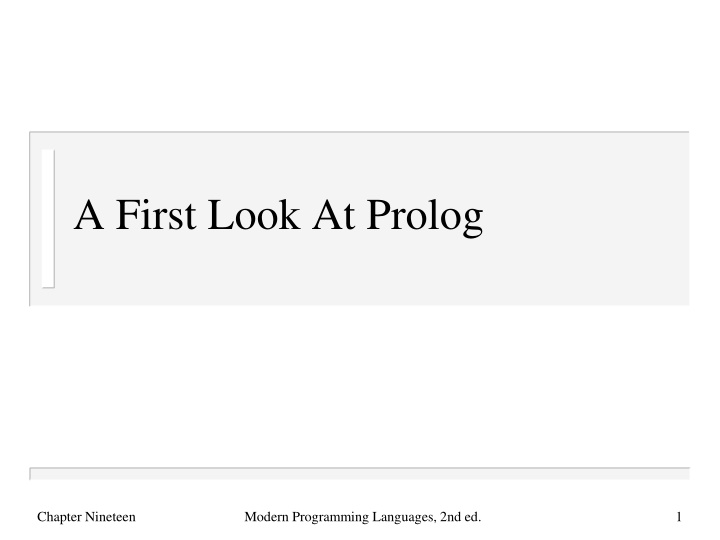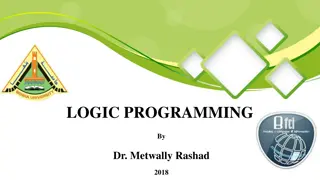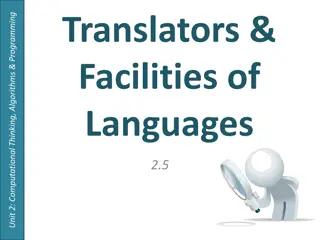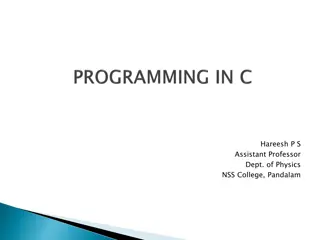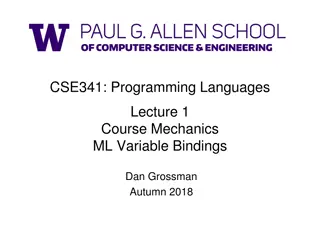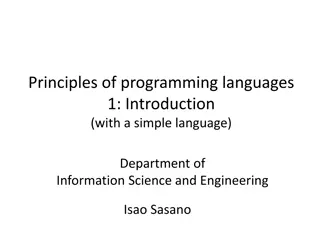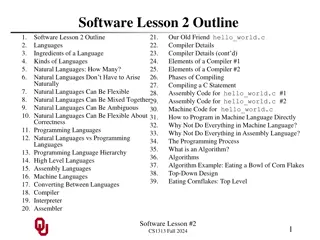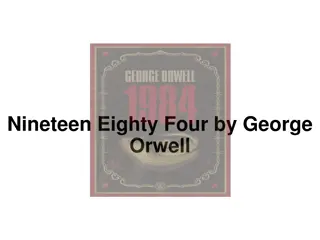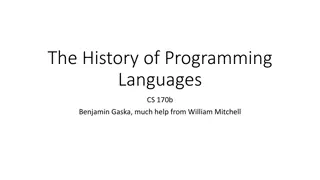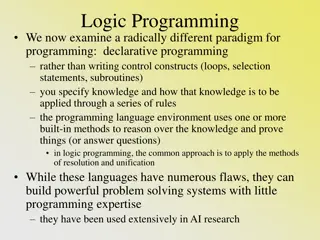A First Look at Prolog: Chapter Nineteen Modern Programming Languages
Rules, operators, lists, and more in Prolog programming. Learn about constants, atoms, variables, and compound terms as fundamental building blocks. Dive into the versatile world of Prolog as a modern programming language platform.
Uploaded on Mar 04, 2025 | 1 Views
Download Presentation

Please find below an Image/Link to download the presentation.
The content on the website is provided AS IS for your information and personal use only. It may not be sold, licensed, or shared on other websites without obtaining consent from the author.If you encounter any issues during the download, it is possible that the publisher has removed the file from their server.
You are allowed to download the files provided on this website for personal or commercial use, subject to the condition that they are used lawfully. All files are the property of their respective owners.
The content on the website is provided AS IS for your information and personal use only. It may not be sold, licensed, or shared on other websites without obtaining consent from the author.
E N D
Presentation Transcript
A First Look At Prolog Chapter Nineteen Modern Programming Languages, 2nd ed. 1
Outline Terms Using a Prolog language system Rules The two faces of Prolog Operators Lists Negation and failure What Prolog is good for Chapter Nineteen Modern Programming Languages, 2nd ed. 2
Terms Everything in Prolog is built from terms: Prolog programs The data manipulated by Prolog programs Three kinds of terms: Constants: integers, real numbers, atoms Variables Compound terms Chapter Nineteen Modern Programming Languages, 2nd ed. 3
Constants Integer constants: 123 Real constants: 1.23 Atoms: A lowercase letter followed by any number of additional letters, digits or underscores: fred A sequence of non-alphanumeric characters: *, ., =, @#$ Plus a few special atoms: [] Chapter Nineteen Modern Programming Languages, 2nd ed. 4
Atoms Are Not Variables An atom can look like an ML or Java variable: i, size, length But an atom is not a variable; it is not bound to anything, never equal to anything else Think of atoms as being more like string constants: "i", "size", "length" Chapter Nineteen Modern Programming Languages, 2nd ed. 5
Variables Any name beginning with an uppercase letter or an underscore, followed by any number of additional letters, digits or underscores: X, Child, Fred, _, _123 Most of the variables you write will start with an uppercase letter Those starting with an underscore, including _, get special treatment Chapter Nineteen Modern Programming Languages, 2nd ed. 6
Compound Terms An atom followed by a parenthesized, comma-separated list of one or more terms: x(y,z), +(1,2), .(1,[]), parent(adam,seth), x(Y,x(Y,Z)) A compound term can look like an ML function call: f(x,y) Again, this is misleading Think of them as structured data Chapter Nineteen Modern Programming Languages, 2nd ed. 7
Terms <term> ::= <constant>|<variable> |<compound-term> <constant> ::= <integer> |<real number> | <atom> <compound-term> ::= <atom> ( <termlist> ) <termlist> ::= <term>|<term> , <termlist> All Prolog programs and data are built from such terms Later, we will see that, for instance, +(1,2) is usually written as 1+2 But these are not new kinds of terms, just abbreviations Chapter Nineteen Modern Programming Languages, 2nd ed. 8
Unification Pattern-matching using Prolog terms Two terms unify if there is some way of binding their variables that makes them identical For instance, parent(adam,Child) and parent(adam,seth) unify by binding the variable Child to the atom seth More details later: Chapter 20 Chapter Nineteen Modern Programming Languages, 2nd ed. 9
The Prolog Database A Prolog language system maintains a collection of facts and rules of inference It is like an internal database that changes as the Prolog language system runs A Prolog program is just a set of data for this database The simplest kind of thing in the database is a fact: a term followed by a period Chapter Nineteen Modern Programming Languages, 2nd ed. 10
Example parent(kim,holly). parent(margaret,kim). parent(margaret,kent). parent(esther,margaret). parent(herbert,margaret). parent(herbert,jean). A Prolog program of six facts Defining a predicateparent of arity 2 We would naturally interpret these as facts about families: Kim is the parent of Holly and so on Chapter Nineteen Modern Programming Languages, 2nd ed. 11
Outline Terms Using a Prolog language system Rules The two faces of Prolog Operators Lists Negation and failure What Prolog is good for Chapter Nineteen Modern Programming Languages, 2nd ed. 12
SWI-Prolog Welcome to SWI-Prolog For help, use ?- help(Topic). or ?- apropos(Word). ?- Prompting for a query with ?- Normally interactive: get query, print result, repeat Chapter Nineteen Modern Programming Languages, 2nd ed. 13
The consult Predicate ?- consult(relations). % relations compiled 0.00 sec, 852 bytes true. ?- Predefined predicate to read a program from a file into the database File relations (or relations.pl) contains our parent facts Chapter Nineteen Modern Programming Languages, 2nd ed. 14
Simple Queries ?- parent(margaret,kent). true. ?- parent(fred,pebbles). false. ?- A query asks the language system to prove something Some turn out to be true, some false (Some queries, like consult, are executed only for their side-effects) Chapter Nineteen Modern Programming Languages, 2nd ed. 15
Final Period ?- parent(margaret,kent) | . true. ?- Queries can take multiple lines If you forget the final period, Prolog prompts for more input with | Chapter Nineteen Modern Programming Languages, 2nd ed. 16
Queries With Variables ?- parent(P,jean). P = herbert. ?- parent(P,esther). false. Any term can appear as a query, including a term with variables The Prolog system shows the bindings necessary to prove the query Chapter Nineteen Modern Programming Languages, 2nd ed. 17
Flexibility Normally, variables can appear in any or all positions in a query: parent(Parent,jean) parent(esther,Child) parent(Parent,Child) parent(Person,Person) Chapter Nineteen Modern Programming Languages, 2nd ed. 18
Multiple Solutions ?- parent(Parent,Child). Parent = kim, Child = holly . When the system finds a solution, it prints the binding it found If it could continue to search for additional solutions, it then prompts for input Hitting Enter makes it stop searching and print the final period Chapter Nineteen Modern Programming Languages, 2nd ed. 19
Multiple Solutions entering a semicolon makes it continue the search As often as you do this, it will try to find another solution In this case, there is one for every fact in the database ?- parent(Parent,Child). Parent = kim, Child = holly ; Parent = margaret, Child = kim ; Parent = margaret, Child = kent ; Parent = esther, Child = margaret ; Parent = herbert, Child = margaret ; Parent = herbert, Child = jean. Chapter Nineteen Modern Programming Languages, 2nd ed. 20
Conjunctions ?- parent(margaret,X), parent(X,holly). X = kim . A conjunctive query has a list of query terms separated by commas The Prolog system tries prove them all (using a single set of bindings) Chapter Nineteen Modern Programming Languages, 2nd ed. 21
?- parent(Parent,kim), parent(Grandparent,Parent). Parent = margaret, Grandparent = esther ; Parent = margaret, Grandparent = herbert ; false. ?- parent(esther,Child), | parent(Child,Grandchild), | parent(Grandchild,GreatGrandchild). Child = margaret, Grandchild = kim, GreatGrandchild = holly . Chapter Nineteen Modern Programming Languages, 2nd ed. 22
Outline Terms Using a Prolog language system Rules The two faces of Prolog Operators Lists Negation and failure What Prolog is good for Chapter Nineteen Modern Programming Languages, 2nd ed. 23
The Need For Rules Previous example had a lengthy query for great-grandchildren of Esther It would be nicer to query directly: greatgrandparent(esther,GGC) But we do not want to add separate facts of that form to the database The relation should follow from the parent relation already defined Chapter Nineteen Modern Programming Languages, 2nd ed. 24
A Rule head greatgrandparent(GGP,GGC) :- parent(GGP,GP), parent(GP,P), parent(P,GGC). conditions A rule says how to prove something: to prove the head, prove the conditions To prove greatgrandparent(GGP,GGC), find some GP and P for which you can prove parent(GGP,GP), then parent(GP,P) and then finally parent(P,GGC) Chapter Nineteen Modern Programming Languages, 2nd ed. 25
A Program With The Rule parent(kim,holly). parent(margaret,kim). parent(margaret,kent). parent(esther,margaret). parent(herbert,margaret). parent(herbert,jean). greatgrandparent(GGP,GGC) :- parent(GGP,GP), parent(GP,P), parent(P,GGC). A program consists of a list of clauses A clause is either a fact or a rule, and ends with a period Chapter Nineteen Modern Programming Languages, 2nd ed. 26
Example ?- greatgrandparent(esther,GreatGrandchild). GreatGrandchild = holly . This shows the initial query and final result Internally, there are intermediate goals: The first goal is the initial query The next is what remains to be proved after transforming the first goal using one of the clauses (in this case, the greatgrandparent rule) And so on, until nothing remains to be proved Chapter Nineteen Modern Programming Languages, 2nd ed. 27
1. parent(kim,holly). 2. parent(margaret,kim). 3. parent(margaret,kent). 4. parent(esther,margaret). 5. parent(herbert,margaret). 6. parent(herbert,jean). 7. greatgrandparent(GGP,GGC) :- parent(GGP,GP), parent(GP,P), parent(P,GGC). We will see more about Prolog s model of execution in Chapter 20 greatgrandparent(esther,GreatGrandchild) Clause 7, binding GGP to esther and GGC to GreatGrandChild parent(esther,GP), parent(GP,P), parent(P,GreatGrandchild) Clause 4, binding GP to margaret parent(margaret,P), parent(P,GreatGrandchild) Clause 2, binding P to kim parent(kim,GreatGrandchild) Clause 1, binding GreatGrandchild to holly Chapter Nineteen Modern Programming Languages, 2nd ed. 28
Rules Using Other Rules grandparent(GP,GC) :- parent(GP,P), parent(P,GC). greatgrandparent(GGP,GGC) :- grandparent(GGP,P), parent(P,GGC). Same relation, defined indirectly Note that both clauses use a variable P The scope of the definition of a variable is the clause that contains it Chapter Nineteen Modern Programming Languages, 2nd ed. 29
Recursive Rules ancestor(X,Y) :- parent(X,Y). ancestor(X,Y) :- parent(Z,Y), ancestor(X,Z). X is an ancestor of Y if: Base case: X is a parent of Y Recursive case: there is some Z such that Z is a parent of Y, and X is an ancestor of Z Prolog tries rules in the order you give them, so put base-case rules and facts first Chapter Nineteen Modern Programming Languages, 2nd ed. 30
?- ancestor(jean,jean). false. ?- ancestor(kim,holly). true . ?- ancestor(A,holly). A = kim ; A = margaret ; A = esther ; A = herbert ; false. Chapter Nineteen Modern Programming Languages, 2nd ed. 31
Core Syntax Of Prolog You have seen the complete core syntax: <clause> ::= <fact> |<rule> <fact> ::= <term> . <rule> ::= <term> :- <termlist> . <termlist> ::= <term>|<term> , <termlist> There is not much more syntax for Prolog than this: it is a very simple language Syntactically, that is! Chapter Nineteen Modern Programming Languages, 2nd ed. 32
Outline Terms Using a Prolog language system Rules The two faces of Prolog Operators Lists Negation and failure What Prolog is good for Chapter Nineteen Modern Programming Languages, 2nd ed. 33
The Procedural Side greatgrandparent(GGP,GGC) :- parent(GGP,GP), parent(GP,P), parent(P,GGC). A rule says how to prove something: To prove greatgrandparent(GGP,GGC), find some GP and P for which you can prove parent(GGP,GP), then parent(GP,P) and then finally parent(P,GGC) A Prolog program specifies proof procedures for queries Chapter Nineteen Modern Programming Languages, 2nd ed. 34
The Declarative Side A rule is a logical assertion: For all bindings of GGP, GP, P, and GGC, if parent(GGP,GP) and parent(GP,P) and parent(P,GGC), then greatgrandparent(GGP,GGC) Just a formula it doesn t say how to do anything it just makes an assertion: ( greatgrand ) ( ) ( ) GGP , , , . parent , parent , parent , GP P GGC GGP GP GP P P GGC ( ) parent , GGP GGC Chapter Nineteen Modern Programming Languages, 2nd ed. 35
Declarative Languages Each piece of the program corresponds to a simple mathematical abstraction Prolog clauses formulas in first-order logic ML fun definitions functions Many people use declarative as the opposite of imperative, including both logic languages and functional languages Chapter Nineteen Modern Programming Languages, 2nd ed. 36
Declarative Advantages Imperative languages are doomed to subtle side-effects and interdependencies Simpler declarative semantics makes it easier to develop and maintain correct programs Higher-level, more like automatic programming: describe the problem and have the computer write the program Chapter Nineteen Modern Programming Languages, 2nd ed. 37
Prolog Has Both Aspects Partly declarative A Prolog program has logical content Partly procedural A Prolog program has procedural concerns: clause ordering, condition ordering, side- effecting predicates, etc. It is important to be aware of both Chapter Nineteen Modern Programming Languages, 2nd ed. 38
Outline Terms Using a Prolog language system Rules The two faces of Prolog Operators Lists Negation and failure What Prolog is good for Chapter Nineteen Modern Programming Languages, 2nd ed. 39
Operators Prolog has some predefined operators (and the ability to define new ones) An operator is just a predicate for which a special abbreviated syntax is supported Chapter Nineteen Modern Programming Languages, 2nd ed. 40
The = Predicate The goal =(X,Y) succeeds if and only if X and Y can be unified: ?- =(parent(adam,seth),parent(adam,X)). X = seth. Since = is an operator, it can be and usually is written like this: ?- parent(adam,seth)=parent(adam,X). X = seth. Chapter Nineteen Modern Programming Languages, 2nd ed. 41
Arithmetic Operators Predicates +, -, * and / are operators too, with the usual precedence and associativity ?- X = +(1,*(2,3)). X = 1+2*3. Prolog lets you use operator notation, and prints it out that way, but the underlying term is still +(1,*(2,3)) ?- X = 1+2*3. X = 1+2*3. Chapter Nineteen Modern Programming Languages, 2nd ed. 42
Not Evaluated ?- +(X,Y) = 1+2*3. X = 1, Y = 2*3. ?- 7 = 1+2*3. false. The term is still +(1,*(2,3)) It is not evaluated There is a way to make Prolog evaluate such terms, but we won t need it yet Chapter Nineteen Modern Programming Languages, 2nd ed. 43
Outline Terms Using a Prolog language system Rules The two faces of Prolog Operators Lists Negation and failure What Prolog is good for Chapter Nineteen Modern Programming Languages, 2nd ed. 44
Lists in Prolog A bit like ML lists The atom [] represents the empty list A predicate .corresponds to ML s :: operator ML expression Prolog term [] [] 1::[] .(1,[]) 1::2::3::[] .(1,.(2,.(3,[]))) No equivalent. .(1,.(parent(X,Y),[])) Chapter Nineteen Modern Programming Languages, 2nd ed. 45
List Notation List notation Term denoted [] [1] [1,2,3] [1,parent(X,Y)] [] .(1,[]) .(1,.(2,.(3,[]))) .(1,.(parent(X,Y),[])) ML-style notation for lists These are just abbreviations for the underlying term using the . Predicate Prolog usually displays lists in this notation Chapter Nineteen Modern Programming Languages, 2nd ed. 46
Example ?- X = .(1,.(2,.(3,[]))). X = [1, 2, 3]. ?- .(X,Y) = [1,2,3]. X = 1, Y = [2, 3]. Chapter Nineteen Modern Programming Languages, 2nd ed. 47
List Notation With Tail List notation [1|X] [1,2|X] [1,2|[3,4]] Term denoted .(1,X) .(1,.(2,X)) same as [1,2,3,4] Last in a list can be the symbol | followed by a final term for the tail of the list Useful in patterns: [1,2|X] unifies with any list that starts with 1,2 and binds X to the tail ?- [1,2|X] = [1,2,3,4,5]. X = [3, 4, 5]. Chapter Nineteen Modern Programming Languages, 2nd ed. 48
The append Predicate ?- append([1,2],[3,4],Z). Z = [1, 2, 3, 4]. Predefined append(X,Y,Z) succeeds if and only if Z is the result of appending the list Y onto the end of the list X Chapter Nineteen Modern Programming Languages, 2nd ed. 49
Not Just A Function ?- append(X,[3,4],[1,2,3,4]). X = [1, 2] . append can be used with any pattern of instantiation (that is, with variables in any positions) Chapter Nineteen Modern Programming Languages, 2nd ed. 50
